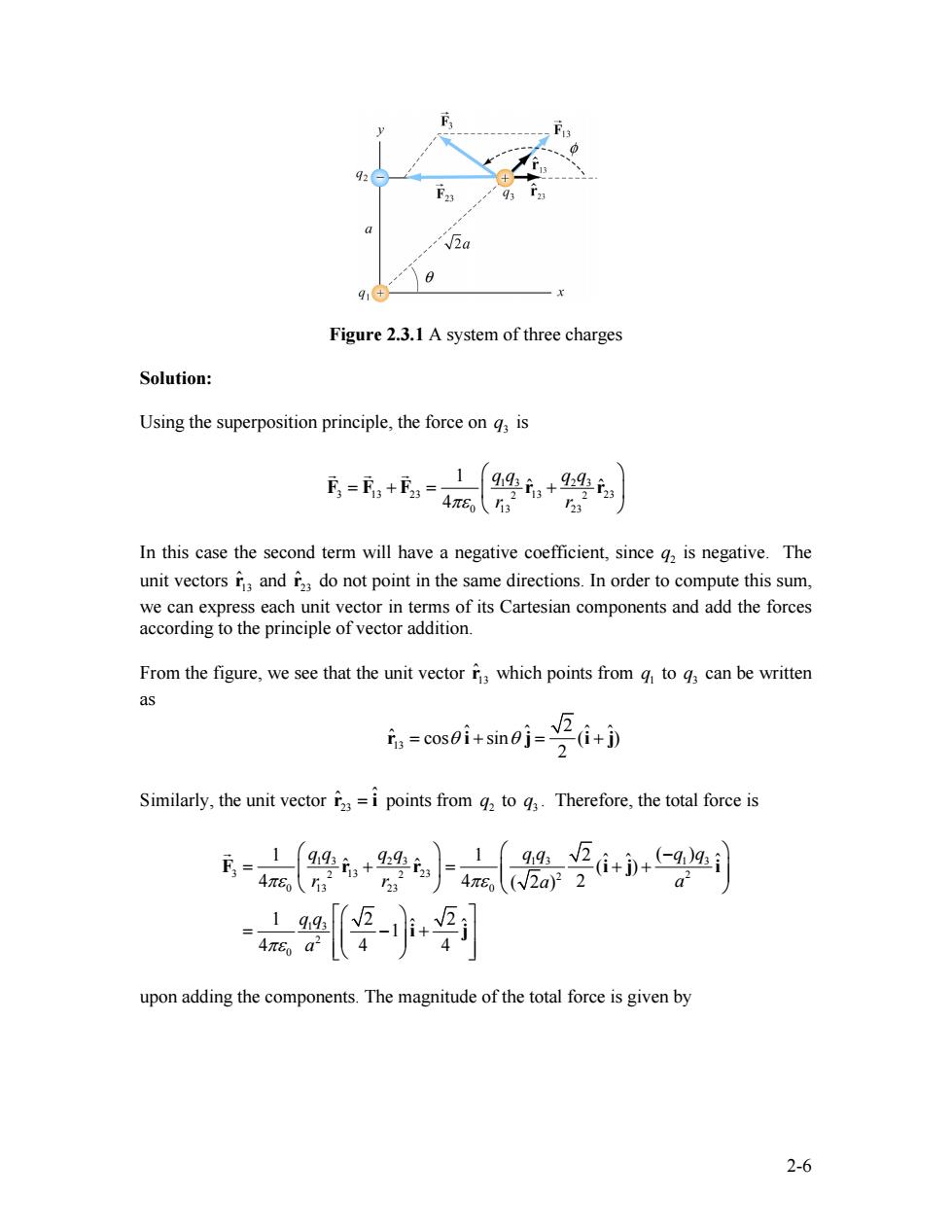
1 92- a 91+ Figure 2.3.1 A system of three charges Solution: Using the superposition principle,the force on g:is 10 E=+= 49i+99i In this case the second term will have a negative coefficient,since g2 is negative.The unit vectors and do not point in the same directions.In order to compute this sum, we can express each unit vector in terms of its Cartesian components and add the forces according to the principle of vector addition. From the figure,we see that the unit vector r which points from g to g3 can be written as -oim0j-9i+i Similarly,the unit vector=i points from to Therefore,the total force is F= 1 警+学小{%n, (2a)22 1 4T60 upon adding the components.The magnitude of the total force is given by 2-6
Figure 2.3.1 A system of three charges Solution: Using the superposition principle, the force on is 3 q 1 3 2 3 3 13 23 2 2 13 23 0 13 23 1 ˆ ˆ 4 q q q q πε r r ⎛ ⎞ = + = ⎜ ⎟ + ⎝ ⎠ F F F r r G G G In this case the second term will have a negative coefficient, since is negative. The unit vectors and do not point in the same directions. In order to compute this sum, we can express each unit vector in terms of its Cartesian components and add the forces according to the principle of vector addition. 2 q 13 rˆ 23 rˆ From the figure, we see that the unit vector which points from to can be written as 13 rˆ 1 q 3 q 13 2 ˆ ˆ ˆ ˆ cos sin ( ) 2 ˆ r i = θ θ + =j i + j Similarly, the unit vector points from to . Therefore, the total force is 23 ˆ rˆ = i 2 q 3 q 1 3 2 3 1 3 1 3 3 1 2 2 3 23 2 2 0 13 23 0 1 3 2 0 1 1 2 ( ) ˆ ˆ ˆ ˆ ˆ ( ) 4 4 ( 2 ) 2 1 2 2 ˆ ˆ 1 4 4 4 q q q q q q q q r r a a q q a πε πε πε ⎛ ⎞ ⎛ ⎞ − = + ⎜ ⎟ = ⎜ ⎟ + + ⎝ ⎠ ⎝ ⎠ ⎡ ⎤ ⎛ ⎞ = − ⎢ ⎥ ⎜ ⎟ + ⎣ ⎦ ⎝ ⎠ F r r i j i i j G upon adding the components. The magnitude of the total force is given by 2-6
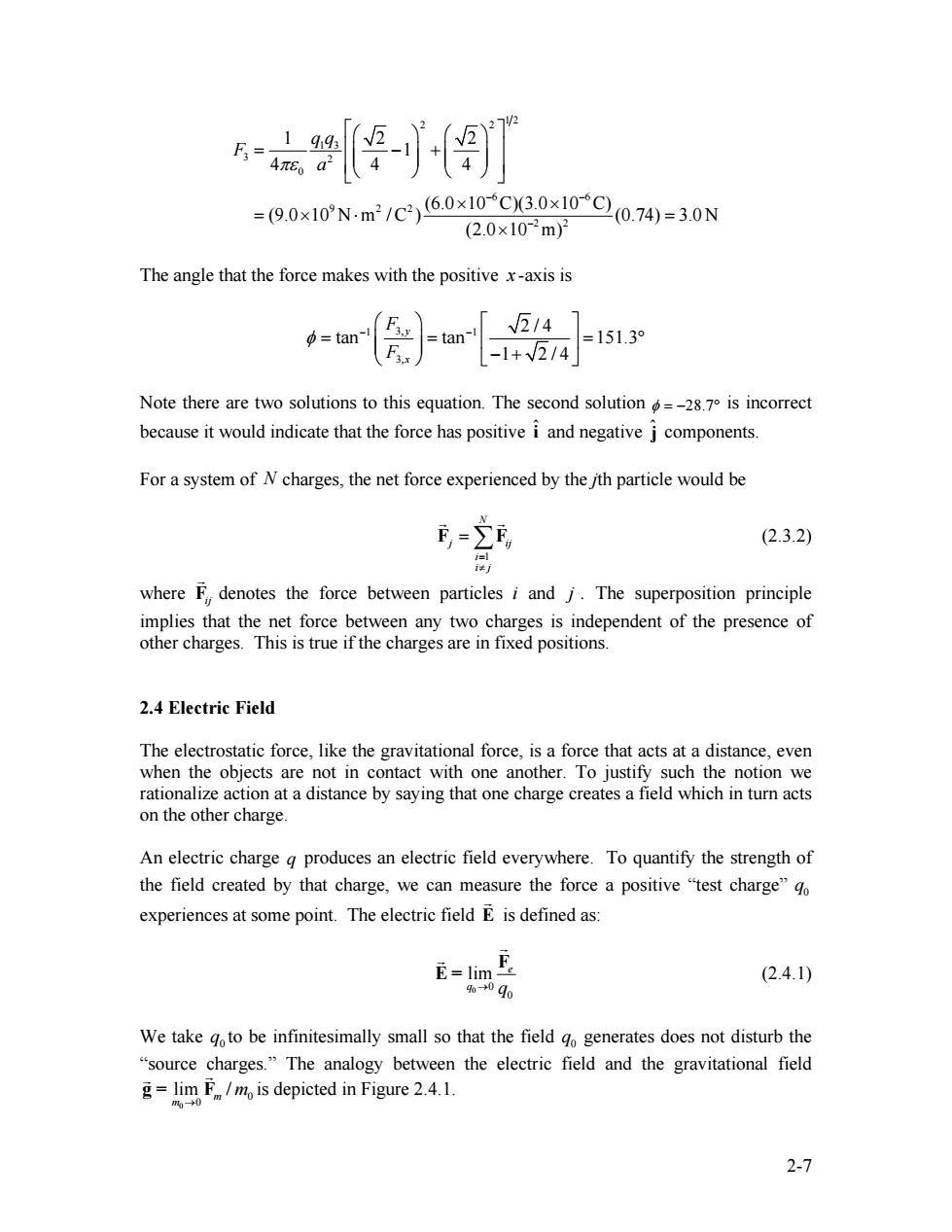
-婴停-j =9.0x10N.m21c6.0x10C30x10*C0.74=30N (2.0×10-2m)2 The angle that the force makes with the positive x-axis is tar tan-i 514 =151.3° -1+V2/4 Note there are two solutions to this equation.The second solution 6=-28.7 is incorrect because it would indicate that the force has positive i and negative j components For a system of N charges,the net force experienced by the jth particle would be (2.3.2) i法j where F denotes the force between particles i and j.The superposition principle implies that the net force between any two charges is independent of the presence of other charges.This is true if the charges are in fixed positions. 2.4 Electric Field The electrostatic force,like the gravitational force,is a force that acts at a distance,even when the objects are not in contact with one another.To justify such the notion we rationalize action at a distance by saying that one charge creates a field which in turn acts on the other charge. An electric charge g produces an electric field everywhere.To quantify the strength of the field created by that charge,we can measure the force a positive "test charge"o experiences at some point.The electric field E is defined as: E=limE (2.4.1) 9%0q0 We take goto be infinitesimally small so that the field go generates does not disturb the "source charges."The analogy between the electric field and the gravitational field g=lim F/m is depicted in Figure 2.4.1. 2-7
1 2 2 2 1 3 3 2 0 6 6 9 2 2 2 2 1 2 2 1 4 4 4 (6.0 10 C)(3.0 10 C) (9.0 10 N m /C ) (0.74) 3.0 N (2.0 10 m) q q F πε a − − − ⎡ ⎤ ⎛ ⎞ ⎛ ⎞ = − ⎢ ⎥ ⎜ ⎟ + ⎜ ⎟ ⎜ ⎟ ⎢ ⎥ ⎝ ⎠ ⎝ ⎠ ⎣ ⎦ × × = × ⋅ = × The angle that the force makes with the positive x -axis is 1 1 3, 3, 2 / 4 tan tan 151.3 1 2 / 4 y x F F φ − − ⎛ ⎞ ⎡ ⎤ = = ⎜ ⎟ ⎢ ⎥ = ⎜ ⎟ ⎣ ⎦ − + ⎝ ⎠ ° Note there are two solutions to this equation. The second solution φ = −28.7° is incorrect because it would indicate that the force has positive and negative ˆ ˆ i j components. For a system of N charges, the net force experienced by the jth particle would be 1 N j i i j = ≠ F = ∑Fij G G (2.3.2) where denotes the force between particles i and Fij G j . The superposition principle implies that the net force between any two charges is independent of the presence of other charges. This is true if the charges are in fixed positions. 2.4 Electric Field The electrostatic force, like the gravitational force, is a force that acts at a distance, even when the objects are not in contact with one another. To justify such the notion we rationalize action at a distance by saying that one charge creates a field which in turn acts on the other charge. An electric charge q produces an electric field everywhere. To quantify the strength of the field created by that charge, we can measure the force a positive “test charge” experiences at some point. The electric field E 0 q G is defined as: 0 0 0 lim e q → q F E = G G (2.4.1) We take to be infinitesimally small so that the field generates does not disturb the “source charges.” The analogy between the electric field and the gravitational field is depicted in Figure 2.4.1. 0 q 0 q 0 0 0 lim / m m m → g = F G G 2-7
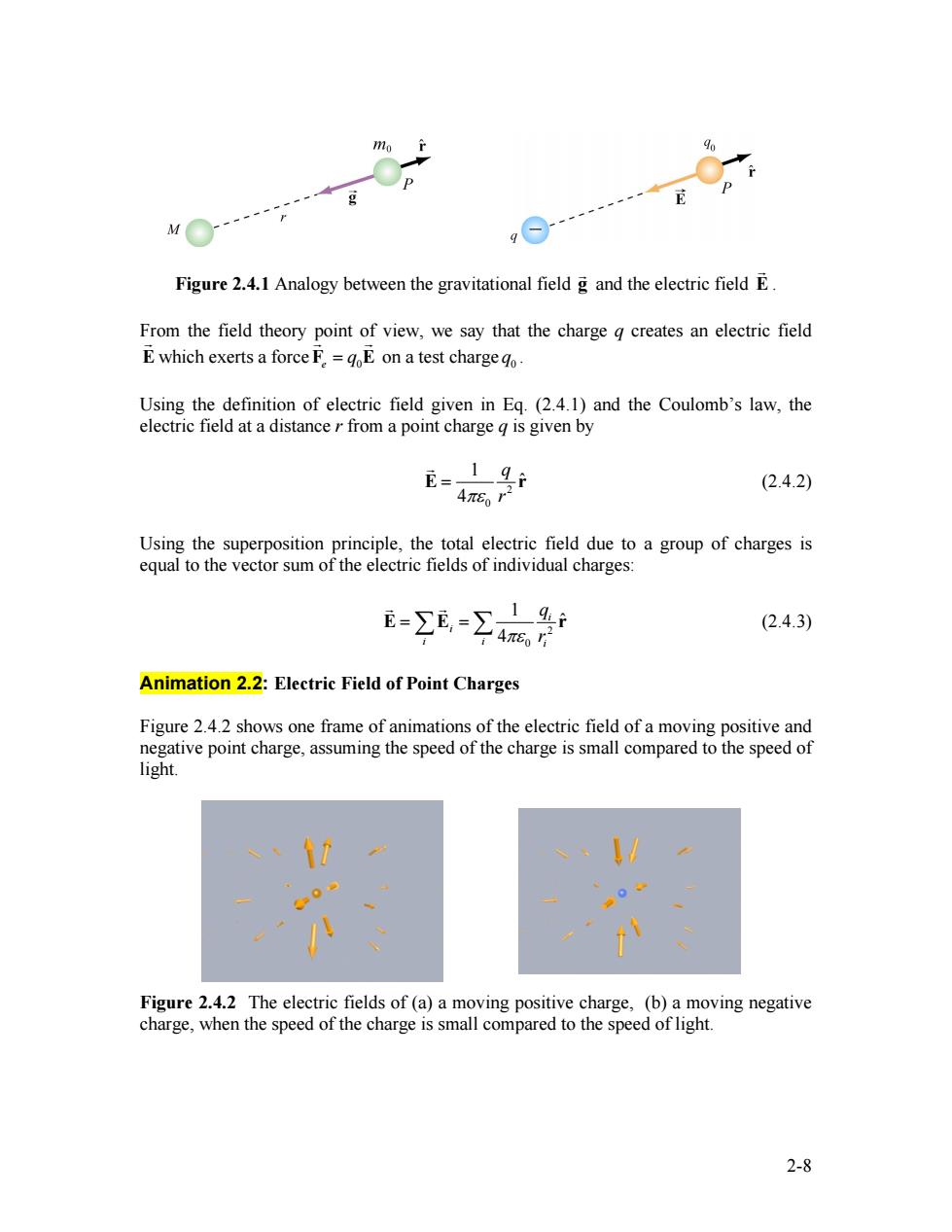
m Figure 2.4.1 Analogy between the gravitational field g and the electric field E. From the field theory point of view,we say that the charge g creates an electric field E which exerts a forceF=oE on a test charge do. Using the definition of electric field given in Eq.(2.4.1)and the Coulomb's law,the electric field at a distance r from a point charge g is given by E=,19: (2.4.2) 4π60r1 Using the superposition principle,the total electric field due to a group of charges is equal to the vector sum of the electric fields of individual charges: 重-2E-2是 (2.4.3) Animation 2.2:Electric Field of Point Charges Figure 2.4.2 shows one frame of animations of the electric field of a moving positive and negative point charge,assuming the speed of the charge is small compared to the speed of light. Figure 2.4.2 The electric fields of(a)a moving positive charge,(b)a moving negative charge,when the speed of the charge is small compared to the speed of light. 2-8
Figure 2.4.1 Analogy between the gravitational field g G and the electric field E . G From the field theory point of view, we say that the charge q creates an electric field E which exerts a force on a test charge . G e 0 F = q G GE 0 q Using the definition of electric field given in Eq. (2.4.1) and the Coulomb’s law, the electric field at a distance r from a point charge q is given by 2 0 1 ˆ 4 q πε r E = r G (2.4.2) Using the superposition principle, the total electric field due to a group of charges is equal to the vector sum of the electric fields of individual charges: 2 0 1 ˆ 4 i i i i i q πε r E E = = ∑ ∑ r G G (2.4.3) Animation 2.2: Electric Field of Point Charges Figure 2.4.2 shows one frame of animations of the electric field of a moving positive and negative point charge, assuming the speed of the charge is small compared to the speed of light. Figure 2.4.2 The electric fields of (a) a moving positive charge, (b) a moving negative charge, when the speed of the charge is small compared to the speed of light. 2-8
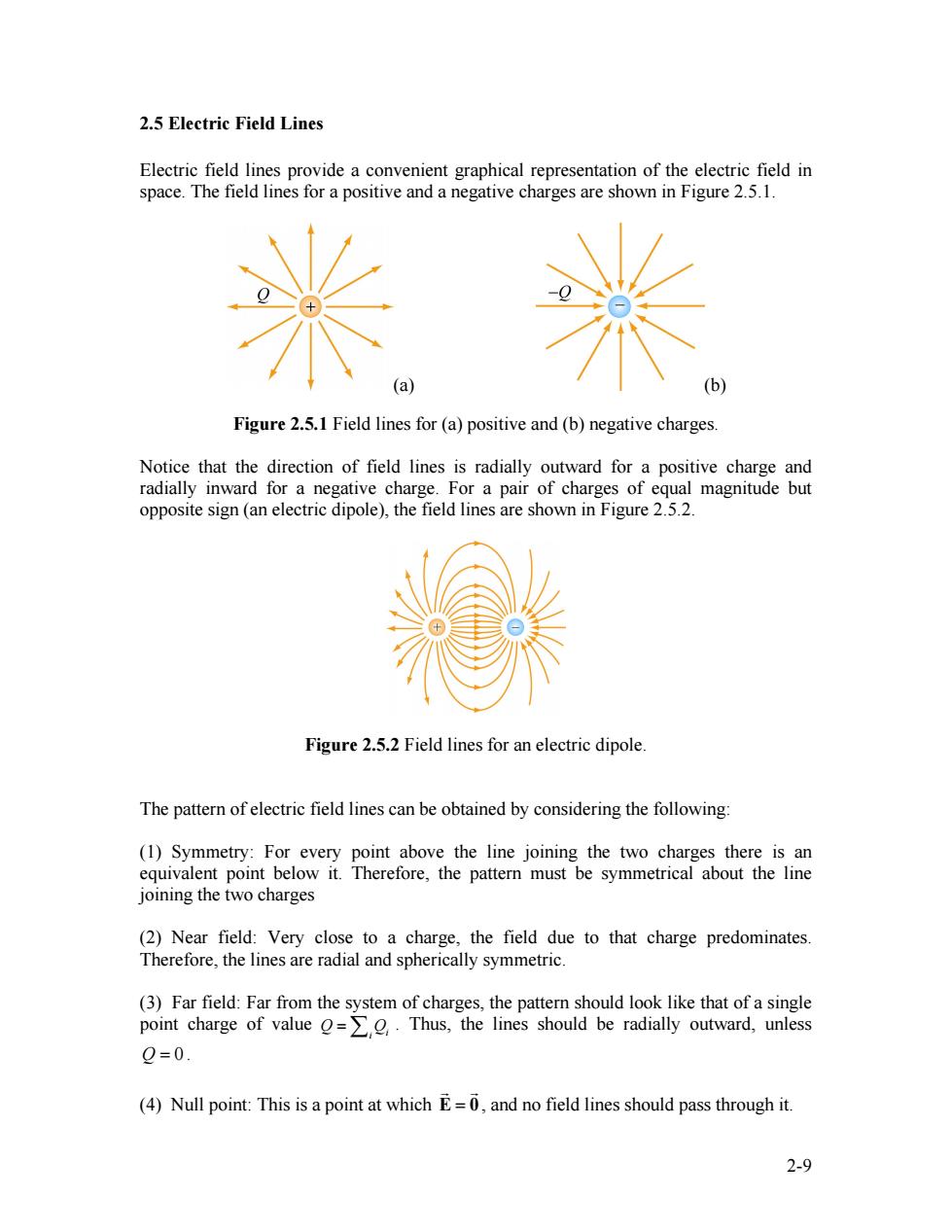
2.5 Electric Field Lines Electric field lines provide a convenient graphical representation of the electric field in space.The field lines for a positive and a negative charges are shown in Figure 2.5.1. (b) Figure 2.5.1 Field lines for (a)positive and (b)negative charges. Notice that the direction of field lines is radially outward for a positive charge and radially inward for a negative charge.For a pair of charges of equal magnitude but opposite sign(an electric dipole),the field lines are shown in Figure 2.5.2. Figure 2.5.2 Field lines for an electric dipole The pattern of electric field lines can be obtained by considering the following: (1)Symmetry:For every point above the line joining the two charges there is an equivalent point below it.Therefore,the pattern must be symmetrical about the line joining the two charges (2)Near field:Very close to a charge,the field due to that charge predominates. Therefore,the lines are radial and spherically symmetric. (3)Far field:Far from the system of charges,the pattern should look like that of a single point charge of value =Thus,the lines should be radially outward,unless Q=0. (4)Null point:This is a point at which E=0,and no field lines should pass through it. 2-9
2.5 Electric Field Lines Electric field lines provide a convenient graphical representation of the electric field in space. The field lines for a positive and a negative charges are shown in Figure 2.5.1. (a) (b) Figure 2.5.1 Field lines for (a) positive and (b) negative charges. Notice that the direction of field lines is radially outward for a positive charge and radially inward for a negative charge. For a pair of charges of equal magnitude but opposite sign (an electric dipole), the field lines are shown in Figure 2.5.2. Figure 2.5.2 Field lines for an electric dipole. The pattern of electric field lines can be obtained by considering the following: (1) Symmetry: For every point above the line joining the two charges there is an equivalent point below it. Therefore, the pattern must be symmetrical about the line joining the two charges (2) Near field: Very close to a charge, the field due to that charge predominates. Therefore, the lines are radial and spherically symmetric. (3) Far field: Far from the system of charges, the pattern should look like that of a single point charge of value . Thus, the lines should be radially outward, unless . i i Q = ∑ Q Q = 0 (4) Null point: This is a point at which E = 0 G G , and no field lines should pass through it. 2-9
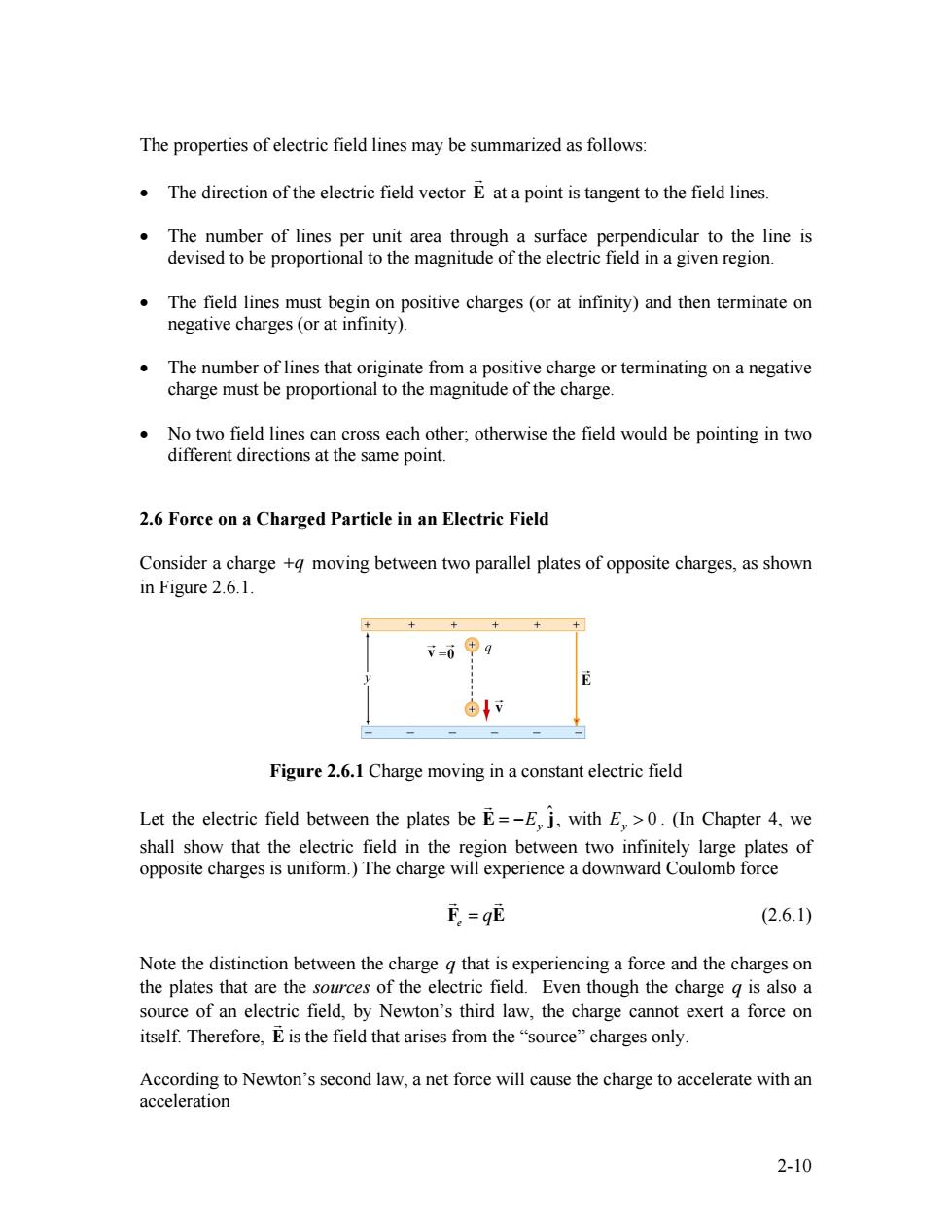
The properties of electric field lines may be summarized as follows: The direction of the electric field vector E at a point is tangent to the field lines. The number of lines per unit area through a surface perpendicular to the line is devised to be proportional to the magnitude of the electric field in a given region. The field lines must begin on positive charges(or at infinity)and then terminate on negative charges (or at infinity). The number of lines that originate from a positive charge or terminating on a negative charge must be proportional to the magnitude of the charge. No two field lines can cross each other;otherwise the field would be pointing in two different directions at the same point. 2.6 Force on a Charged Particle in an Electric Field Consider a charge +q moving between two parallel plates of opposite charges,as shown in Figure 2.6.1. v=0 ⊕g Figure 2.6.1 Charge moving in a constant electric field Let the electric field between the plates be E=-E j,with E0.(In Chapter 4,we shall show that the electric field in the region between two infinitely large plates of opposite charges is uniform.)The charge will experience a downward Coulomb force F=gE (2.6.1) Note the distinction between the charge q that is experiencing a force and the charges on the plates that are the sources of the electric field.Even though the charge g is also a source of an electric field,by Newton's third law,the charge cannot exert a force on itself.Therefore,E is the field that arises from the"source"charges only. According to Newton's second law,a net force will cause the charge to accelerate with an acceleration 2-10
The properties of electric field lines may be summarized as follows: • The direction of the electric field vector E G at a point is tangent to the field lines. • The number of lines per unit area through a surface perpendicular to the line is devised to be proportional to the magnitude of the electric field in a given region. • The field lines must begin on positive charges (or at infinity) and then terminate on negative charges (or at infinity). • The number of lines that originate from a positive charge or terminating on a negative charge must be proportional to the magnitude of the charge. • No two field lines can cross each other; otherwise the field would be pointing in two different directions at the same point. 2.6 Force on a Charged Particle in an Electric Field Consider a charge moving between two parallel plates of opposite charges, as shown in Figure 2.6.1. +q Figure 2.6.1 Charge moving in a constant electric field Let the electric field between the plates be ˆ E = −E y j G , with . (In Chapter 4, we shall show that the electric field in the region between two infinitely large plates of opposite charges is uniform.) The charge will experience a downward Coulomb force 0 E y > e F = qE G G (2.6.1) Note the distinction between the charge that is experiencing a force and the charges on the plates that are the sources of the electric field. Even though the charge is also a source of an electric field, by Newton’s third law, the charge cannot exert a force on itself. Therefore, E G is the field that arises from the “source” charges only. q q According to Newton’s second law, a net force will cause the charge to accelerate with an acceleration 2-10